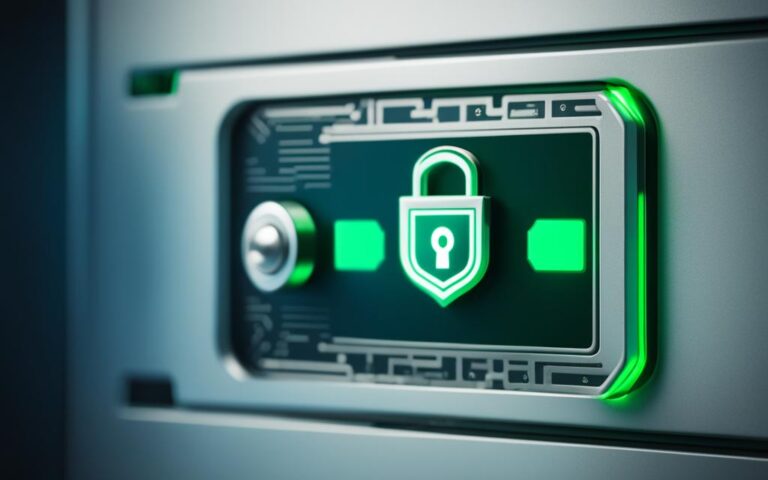The Relationship Between Data Recovery and Cybersecurity
In today’s digital age, data security is of paramount importance for businesses, especially in the United Kingdom. With the increasing frequency and sophistication of cyber attacks, UK businesses must prioritize both data recovery and cybersecurity to protect their valuable assets and maintain business continuity.
Cyber attacks can have devastating consequences, resulting in data breaches, system disruptions, and reputational damage. To mitigate these risks, it is crucial for businesses to establish a strong relationship between data recovery and cybersecurity, as they go hand in hand to ensure resilience in the face of cyber threats.
Implementing effective data recovery measures involves assessing risks, implementing backup best practices, training staff, updating software and hardware, monitoring networks and systems, and regularly reviewing and improving plans. By taking these proactive steps, UK businesses can safeguard their data and strengthen their cybersecurity posture.
In the following sections, we will delve deeper into each aspect of this relationship, exploring the importance of assessing risks and prioritizing data recovery, implementing backup best practices, training staff, updating software and hardware, monitoring networks and systems, and the vital role these elements play in ensuring that UK businesses are well-prepared to recover from cyber attacks and protect their valuable data.
Assessing Risks and Prioritizing Data Recovery
The first crucial step towards effective data recovery after a cyber attack is to assess risks and prioritize the protection of critical assets. This involves a comprehensive analysis of potential threats and vulnerabilities faced by the organization.
One of the key aspects of risk assessment is identifying the most vital data within the organization. This includes determining where the data is stored and backed up, as well as evaluating the frequency of backup updates and tests. By understanding the importance and location of critical assets, businesses can prioritize their data recovery efforts and allocate necessary resources.
Assessing risks also involves evaluating the potential impact of different types of cyber attacks on the organization’s operations and reputation. Understanding the consequences of data breaches, system compromises, and other security incidents allows businesses to prioritize data recovery efforts based on their potential impact.
Furthermore, risk assessment is an ongoing process that needs to be regularly reviewed and updated as new threats emerge and technology evolves. By staying vigilant and keeping up with the latest trends in cyber threats, organizations can proactively assess risks and implement necessary measures to enhance data recovery capabilities.
Key Points:
- Assessing risks is the first step towards effective data recovery after a cyber attack.
- Identify critical assets and determine their location and backup procedures.
- Evaluate potential threats and vulnerabilities to prioritize data recovery efforts.
- Regularly review and update risk assessments to adapt to evolving cyber threats.
Image: Assessing risks is crucial for prioritizing data recovery efforts.
Implementing Backup Best Practices
Implementing effective backup practices is essential for a robust data recovery plan. By following backup best practices, businesses can safeguard their data, enhance cybersecurity, and ensure readiness for potential cyber threats. Here are some key strategies to consider:
- Backup Strategy: Develop a comprehensive backup strategy that outlines the frequency, location, format, and encryption of backups. This strategy should align with the specific needs and priorities of your business. Consider factors such as the criticality of data, recovery time objectives (RTO), and recovery point objectives (RPO).
- Encryption: Employ encryption techniques to protect sensitive data during the backup process. Encryption converts data into unreadable form, making it inaccessible to unauthorized individuals. Use strong encryption algorithms and secure encryption keys to ensure data confidentiality and integrity.
- Backup Verification: Regularly verify the integrity and usability of backups through a backup verification process. This involves testing backup data to ensure it can be successfully restored when needed. By conducting regular backup verification, you can identify any issues or errors early on and take corrective measures.
- 3-2-1 Rule: Adhere to the 3-2-1 rule, which is a widely recognized backup strategy. This rule suggests having at least three copies of data, stored on two different storage media, with one copy kept off-site or in the cloud. This approach provides additional layers of protection against data loss due to hardware failures, natural disasters, or cyber attacks.
Implementing these backup best practices is crucial for ensuring data resilience, reducing the impact of cyber threats, and facilitating smooth data recovery. By taking proactive measures and staying prepared, businesses can mitigate risks and safeguard their valuable data assets.
Key Takeaways:
- Develop a comprehensive backup strategy that aligns with your business needs.
- Use encryption techniques to protect sensitive data during the backup process.
- Regularly verify the integrity and usability of backups through backup verification.
- Follow the 3-2-1 rule by keeping at least three copies of data on two different storage media.
Training Staff for Data Recovery
Training staff on how to handle data loss incidents is crucial for ensuring a swift and effective data recovery process. One important aspect of training is the development of a comprehensive recovery policy that outlines the roles, responsibilities, steps, procedures, communication channels, and escalation paths to be followed during a data recovery operation.
An effective recovery policy serves as a guide for staff, enabling them to understand their roles and responsibilities and take appropriate actions in a coordinated and efficient manner. It provides clarity on the necessary steps to be taken, ensuring a structured and consistent approach to data recovery.
In addition to the recovery policy, regular drills and simulations are essential for testing the effectiveness of the data recovery plan and fostering a culture of readiness among staff members. These exercises allow staff to practice their roles and responsibilities in a controlled environment, identify any gaps or weaknesses in the recovery process, and gain confidence in their ability to handle data loss incidents.
The Importance of Drills and Simulations
Drills and simulations provide valuable opportunities for staff to become familiar with the data recovery plan and understand the specific actions they need to take in different scenarios. By simulating real-life situations, staff members can gain practical experience and develop the skills necessary to respond effectively and efficiently in the event of a data loss incident.
During drills and simulations, staff members can also identify any areas that need improvement or refinement in the recovery plan. This feedback can be used to update and enhance the plan, ensuring that it remains current and aligned with the evolving landscape of cybersecurity threats.
“Regular drills and simulations help test the data recovery plan and improve skills and readiness.”
By involving staff in drills and simulations, organizations can foster a sense of ownership and responsibility for data recovery. Staff members become proactive participants in the process, actively contributing to the organization’s overall resilience against cyber attacks.
| Benefits of Training Staff for Data Recovery | Benefits of Drills and Simulations |
|---|---|
|
|
Overall, training staff for data recovery and conducting regular drills and simulations are essential components of a robust cybersecurity strategy. By investing in staff training and fostering a culture of preparedness, organizations can enhance their ability to recover from data loss incidents and safeguard their critical assets.
Updating Software and Hardware
Regularly updating software and hardware is essential for effective data recovery after a cyber attack. By applying patches and updates to operating systems, applications, and devices, businesses can address security flaws and bugs, minimizing the risk of further compromise and facilitating the recovery process. Moreover, upgrading outdated or unsupported software and hardware is crucial to reducing vulnerabilities and ensuring optimal data security and performance.
Software updates, also known as patches, offer critical improvements, bug fixes, and enhanced security features. They are released by software vendors to address known vulnerabilities and protect users against emerging threats. Failing to install these updates promptly can leave systems exposed and increase the likelihood of successful cyber attacks.
“Software updates provide essential security enhancements and must be promptly applied to minimize vulnerabilities and protect against cyber attacks.”
Hardware updates, on the other hand, involve upgrading physical components such as servers, routers, firewalls, and other network devices. Keeping hardware up to date ensures compatibility with the latest software versions and provides access to the most advanced security features and performance optimizations.
In addition to updating software and hardware, it’s equally important to remove obsolete software and hardware from the infrastructure. Legacy systems and unsupported software pose significant security risks as they are often more vulnerable to cyber threats due to the lack of security patches and updates.
Benefits of Updating Software and Hardware
| Benefits | Description |
|---|---|
| Enhanced Security | Software updates and hardware upgrades provide critical security enhancements, reducing vulnerabilities and protecting against cyber attacks. |
| Improved Performance | Updating software and hardware ensures optimal performance, enabling systems to run efficiently and handle data recovery processes effectively. |
| Interoperability | Keeping software and hardware up to date ensures compatibility, allowing seamless integration and efficient data recovery operations. |
| Access to Latest Features | Software and hardware updates provide access to the latest features, functionalities, and advancements, enhancing the data recovery process. |
The continuous update of software and hardware should be a fundamental part of any organization’s cybersecurity strategy. By maintaining an up-to-date infrastructure, businesses can minimize vulnerabilities, improve data recovery capabilities, and mitigate the risks associated with cyber attacks.
Monitoring Networks and Systems
Effective data recovery after a cyber attack relies heavily on constant monitoring of networks and systems. By actively monitoring network traffic and system behavior, businesses can detect and analyze any suspicious or abnormal activity, enabling them to respond swiftly and appropriately.
Various tools and techniques are utilized to monitor networks and systems, including:
- Intrusion detection and prevention systems
- Firewalls
- Antivirus software
- Log analysis
These tools provide critical insights into potential threats and vulnerabilities, allowing businesses to proactively identify and address security breaches.
A comprehensive monitoring strategy involves:
- Real-time monitoring of network traffic to detect any anomalous patterns or unauthorized access attempts.
- Regular analysis of system logs, which can provide valuable information about potential security incidents.
- Continuous monitoring of critical systems and infrastructure to identify vulnerabilities and ensure timely responses.
Alongside monitoring, businesses should also have a well-defined response plan in place. This plan outlines the necessary actions to be taken when suspicious activity is detected. It includes:
- Isolating affected systems or networks to prevent the spread of the attack.
- Containing the threat to minimize the impact on other systems or data.
- Eradicating the threat by removing malicious software and thoroughly investigating and resolving the attack.
By monitoring networks and systems and having a robust response plan, businesses can effectively mitigate the risks associated with cyber attacks and ensure a more efficient data recovery process.
Conclusion
Recovery after a cyber attack is never easy, but resilient organizations are better equipped to bounce back. By prioritizing data recovery, updating software and hardware, training staff, and monitoring networks and systems, businesses can enhance their cybersecurity and be better prepared for data recovery after a cyber attack.
Simulations, drills, and roleplays play a vital role in testing preparedness and recovery readiness. These activities allow organizations to identify and address any gaps in their data recovery plans, ensuring they can respond effectively in the event of an attack.
A well-documented root cause analysis and ongoing testing and review of plans are essential for continuous improvement. By regularly assessing and updating their data recovery strategies, organizations can stay one step ahead of cyber threats and adapt their defenses accordingly.
Building resilience and readiness in the face of evolving cyber risks is crucial. Through a comprehensive approach that combines robust data recovery practices, up-to-date software and hardware, well-trained staff, and proactive monitoring, businesses can minimize the impact of cyber attacks and safeguard their valuable data and assets.












